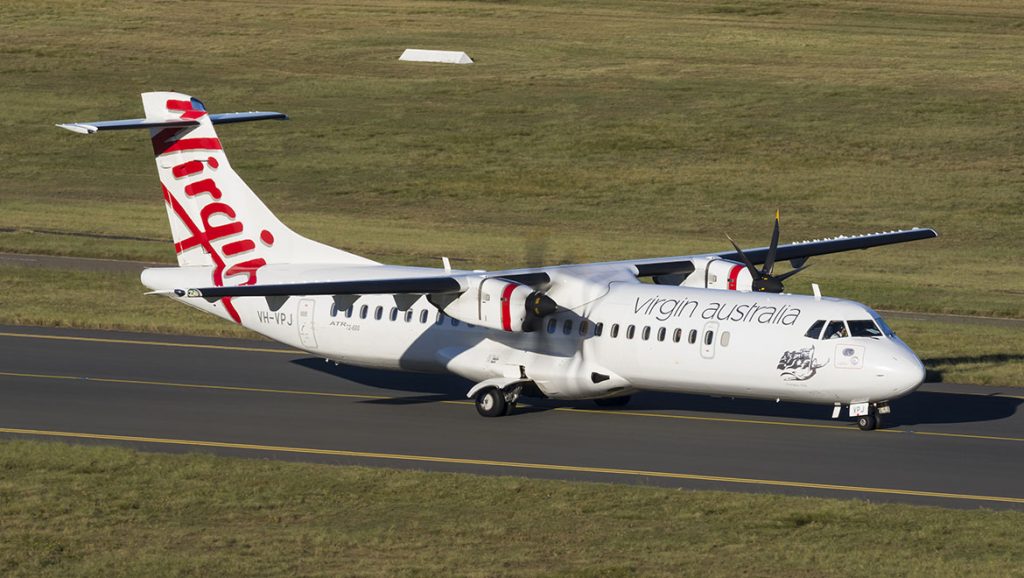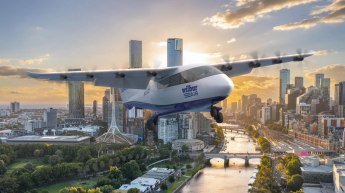
A Virgin Australia ATR72 carrying 66 passengers narrowly avoided crashing into a PA-28 flown by a student pilot.
An ATSB report said the aircraft were “so close” that the smaller aircraft dramatically lowered its nose to avoid a collision on 19 October last year near Albury, NSW.
Incredibly, the investigation also revealed air traffic controllers did not even notice the incident at the time, and said pilots on both aircraft made “incorrect assumptions” and must take responsibility.
A tragedy was only avoided when pilots on the larger aircraft received an automatic collision-avoidance alert and instigated manoeuvres.
“Virgin Australia and Airservices Australia have commenced discussions to convene a cross industry stakeholder meeting to include operators, the Civil Aviation Safety Authority, the ATSB and the broader industry to discuss the ongoing risk to operations at non controlled and Class D airports, such as Albury,” said the ATSB’s director of transport safety, Stuart Macleod.
On 19 October 2019, a Piper PA-28-161, registered VH-XDI (XDI), operated by the Australian Airline Pilot Academy (AAPA), was inbound to Albury from Wagga Wagga, NSW, on a training flight.
The pilot was the only person on board. An ATR72-212A, registered VH-FVR (FVR), operated by Virgin Australia Airlines, was also inbound to Albury on a scheduled passenger flight from Sydney. There were two flight crew, two cabin crew and 66 passengers on board.
After the PA-28 had joined the downwind circuit leg for a touch-and-go landing on Albury’s runway 25, air traffic control informed the PA-28 pilot that “…you’re number two following an ATR on about a four mile final, report traffic in sight”.
The pilot acknowledged the instruction with the aircraft’s callsign, but did not read back any part of the instruction.
The controller later advised the ATSB that, due to their attention being focused on a third aircraft, they were not monitoring the PA-28 as the aircraft continued on downwind and turned on to the base leg of the circuit. At that point the PA-28 pilot had not sighted the ATR nor advised the controller that they did not have it sighted.
Passing through approximately 600 feet above ground level, the ATR crew received a TCAS (traffic collision avoidance system) TA (traffic advisory) alert. They quickly identified the PA-28 below them and immediately commenced a missed approach.
The controller later reported not observing the near collision, and only shifted their attention back to the two aircraft when the ATR crew reported the missed approach. The controller advised that, as the ATR was already conducting a missed approach, they did not issue a safety alert.
The PA-28 pilot, meanwhile, advised the ATSB that when the ATR was first sighted it was so close that they lowered the nose of their aircraft to increase separation. The pilot recalled carrying out normal visual checks to ensure the base and final legs were clear, but did not look along the long final flightpath, assuming that the ATR, which had been cleared to land before the PA-28 joined downwind, was either on short final or had landed.
“As the PA-28 was operating under visual flight rules, separation between the two aircraft was the pilots’ responsibility, and the pilots on both aircraft made incorrect assumptions about both each other’s movements, rather than taking positive action to confirm that adequate separation would be maintained,” Macleod said.
“In addition, the air traffic controller had recognised the potential conflict and implemented a plan to sequence the aircraft’s arrival, however, the controller did not seek confirmation from the PA-28 pilot that they understood the instruction to follow the ATR.”
As well as finding that the PA-28 pilot did not sight the ATR, and did not advise the controller that they did not have the aircraft in sight before turning in front of the ATR, the ATSB’s investigation found the ATR flight crew were aware there was traffic in the area but did not assess the position of the PA-28 until the TCAS traffic advisory alert activated, Macleod noted.
In addition, the investigation found that the controller did not identify the developing near collision as they were not effectively monitoring the aircraft in the circuit area due to their attention being focused on another aircraft.
“The circumstances of this near collision incident illustrates the danger of assumption and incomplete situational awareness,” Macleod said.
A number of safety actions have stemmed from the occurrence and the ATSB’s investigation, Macleod noted.
Alongside the discussions between Virgin and Airservices, AAPA conducted an internal investigation and implemented a number of additional risk controls, including the introduction of regular face-to-face seminars between controllers at Albury Tower and new students to explain operations in Class D airspace before students complete their first solo flight to Albury.
















PB
says:I grow annoyed when I read that ATC is shrugging this off since the Piper was vfr.
The ATR72 was IFR unless it cancelled and elected to continue inbound with VFR.
IFR guarantees only two things – separation from terrain and separation from other traffic. Both aircraft would have transponders, and the controller was totally delinquent in his abandonment of his responsibilities.
Let’s face it – he had three aircraft he was (supposed) to have been dealing with. Three! I fly in America and I’ve been #20 on downwind so don’t let this deeeb claim that he/she was overworked by their being a third aircraft in the control zone.
I’m shocked by this article and the controller’s ineptitude. The situation reminds me of the San Diego PSA 727 where the controller accepted the 727 VFR recognition of traffic and stood aside while the 727 flew into an IFR Cessna 182.
Does it take downing an ATR before someone wakes up to this?
Remember, too, these aircraft are paying for air services – they deserve better than this
Dj Cavanagh
says:With GPS technology you would think all involved would be automatically notified and placed into a higher state of alert and attention.
ToMo
says:The student has just been hired by Pakistani Airways as head pilot.
chris robey
says:Ironically, the Wagga Wagga homebase of the AAPA student, which is just 60nm (approx) to the north of Albury, has an ATC control tower which was built and commissioned in the mid 1980’s, but which was then mothballed within a couple of years. Despite the fact that YSWG is a busy airport with many scheduled movements, it’s attractive TWR remains mothballed three decades later!
Colin Campbell
says:If I had been the controller involved, my instruction would have been, “.. continue downwind until advised, report sighting an ATR on a four mile final.”
Neil Thomas
says:Goodness gracious. It’s quite simple.
All aircraft are required to visually maintain seperation, commensurate with meteorological conditions and their attention at flying the aircraft. Furthermore, VFR must at all times do so.
Here, the circuit is VMC, both aircraft should maintain visual seperation, and the Piper must absolutely do so.
Any failure to do so ought lead to a rescind of licence.
Further, the controller should have only cleared the Piper to join downwind, and to report sight of ‘….. IFR RPT traffic 4 mile final’ before issuing #2, which MUST be read back.
All the rest, collision alerts, incompetence, lazyness, seminars, blame sharing….. is nothing more than the absolute bullshit of our modern times.
No names here.
says:Sensationalist (and disappointing, to be frank) article – written for dramatic effect.
Lazy and overly “diplomatic” findings from ATSB, which has fallen dramatically in the esteem of the industry, from a position of high regard held previously.
It is not high on the list of tasks, for a crew with a landing clearance, to visually aquire other traffic told to remain clear (which can be harder than you might think).
This situation speaks for the safety of aviation, (in the face of Airservices/CASA’s ridiculous D airspace model), not the implied inherent danger the article seeks to describe.
Think about it…
A human error was made, and responses to TCAS systems were carried out in line with training and expectation.
Errors are as common in aviation, as any other industry. What is different is the approach to trapping error, and then managing the consequences.
An undesirable situation ended safely for all concerned.
ATR crews at Virgin had long reported this situation was a distinct chance of happening, and should be addressed.
Adam Thorn
says:I disagree. The ATSB were, by their own standards, fairly scathing at what happened here. I would say it beggars belief that both sets of pilots and air traffic control did not know about this until it was almost too late. We report these stories not to sensationalise, but because it’s our duty to report them in order to warn of the dangers of these incidents, and raise awareness.
Thanks for your comment though. I welcome all feedback, good or bad.
Adam
Emu
says:S*** happens but with it, an aircrash can put a severe dent in Australia’s aviation safety record. So make sure complacency is replaced with (first) class collision avoidance action.
Anon
says:Then Virgin decided to mitigate the risk by completely grounding the ATR fleet permanently….
Russell Jones
says:Regardless of being a Student Pilot, an aircraft already established in the circuit has the right of way, NOT some commercial concern so stop bashing GA you Investigators ??
Chief pylot
says:Russell Jones – read it again. The ATR was already cleared to land. The VFR aircraft was told to follow them, by ATC. OCTA circuit rules do not apply here.